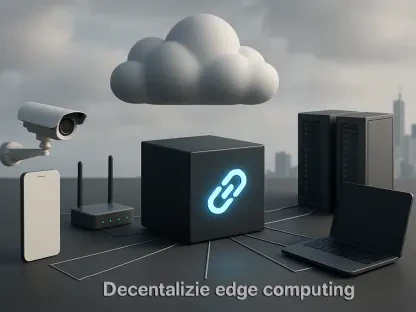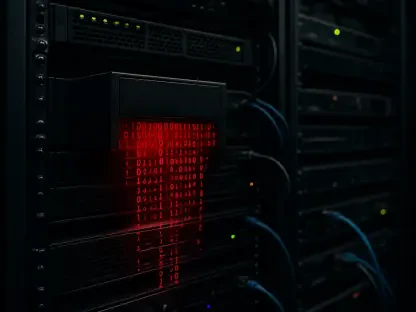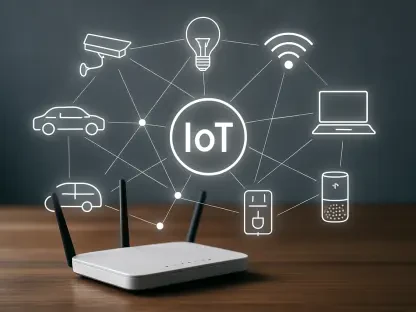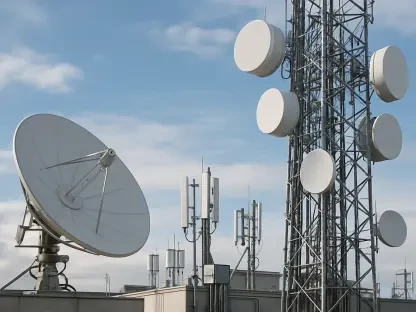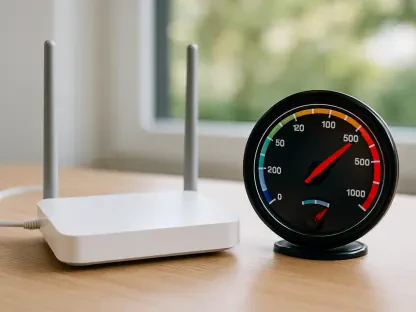The promise of the Internet of Things (IoT) heralds transformative changes in the realm of public safety, offering innovative approaches to enhancing security across urban landscapes worldwide. With the IoT in public safety market forecasted to skyrocket from $31.61 billion in 2023 to $130.19 billion by 2032, the impact of IoT on public safety strategies is undeniable. This growth trajectory reflects a compounded annual growth rate of 17.03%, signifying technological shifts and increasing reliance on interconnected devices for bolstering emergency services and disaster management. Central to this evolution is the technology’s capability to offer real-time data, crucial for efficient public safety operations, as societies strive for smarter, safer living environments. Increased urbanization, rising security threats, and advancements in artificial intelligence and predictive analytics further underscore IoT’s pivotal role in redefining smart city initiatives, enabling rapid, informed decision-making and promoting an integrated response among community safety networks.
Key Growth Drivers
Urban centers worldwide are experiencing a seismic shift toward smart city initiatives, harnessing IoT-powered solutions to pave the way for intelligent infrastructure. This evolution manifests through advanced surveillance networks, intelligent traffic systems, and sophisticated environmental sensors designed to collect and analyze real-time data. This pivotal movement is motivated by a desire to enhance urban management and improve public welfare, aligning with infrastructural goals to create safer city environments. The demand for real-time incident response has soared, driven by the need for immediate alerts among first responders. IoT devices excel in providing situational updates, drastically improving outcomes in emergency scenarios. By facilitating quick and informed decision-making, these technologies empower emergency personnel to act swiftly and efficiently, mitigating potential risks and saving lives.
IoT solutions are proving indispensable in the domain of natural disaster preparedness as well. Monitoring weather patterns, seismic activity, and flooding allows cities to predict events and take proactive measures, significantly reducing the impact of natural calamities. Early warnings and swift evacuations enabled by connected devices ensure communities are better equipped to face environmental challenges. Moreover, the rise in security threats posed by terrorism, public unrest, and crime has propelled the deployment of connected surveillance systems. IoT offers enhanced measures to detect and thwart possible threats, providing real-time data to respond promptly. Meanwhile, integrating artificial intelligence and predictive analytics within IoT ecosystems further optimizes law enforcement and emergency response operations, enabling early detection of risks and coordinated actions to safeguard communities.
Emerging Market Trends
The emergence of connected surveillance systems marks a significant trend as cities increasingly adopt AI-enabled monitoring solutions. These intelligent CCTV cameras enhance real-time communication with law enforcement and facilitate accelerated threat detection and response capabilities. This leap in technological capabilities is reshaping how cities anticipate and address security challenges. Simultaneously, wearables for first responders are revolutionizing how emergency personnel operate on the field. Smart helmets, biometric vests, and GPS-equipped gear empower first responders to monitor health and location variables, ensuring both efficiency and safety during critical operations. These advancements allow for more effective coordination and onsite decision-making in high-stakes situations.
Drone-based monitoring is gaining traction as a significant application of IoT, offering an aerial perspective through real-time data gathering. Equipped with IoT sensors, drones provide invaluable assistance in search, rescue, and crowd control missions. Their versatility makes them crucial assets for public safety operations, ensuring better visibility and insight into unfolding events. Furthermore, interoperable communication platforms facilitated by IoT represent another transformative shift, where data sharing becomes seamless across multiple agencies such as police, fire, medical, and traffic authorities. This interoperability leads to improved coordination, driving higher operational efficiency and ensuring a holistic response during incidents. An emphasis on integrating robust cybersecurity measures is emerging alongside these technological advancements, crucial for safeguarding public safety systems from potential cyber threats.
Application Areas
IoT technologies are finding extensive applications across multiple public safety domains, establishing themselves as integral components of modern infrastructure. Emergency management has become significantly more efficient with the integration of automated alerts and sensor data, dramatically reducing response times during crises like fires or earthquakes. The implementation of IoT in law enforcement has ushered in predictive policing and real-time crime mapping, making high-risk area surveillance more effective. These tools afford law enforcement agencies the ability to be proactive in mitigating crime and enhancing public confidence in safety measures. In disaster response and recovery, IoT provides real-time information from distributed sensors, aiding coordinated evacuation plans and resource deployment. This support leads to better management strategies that minimize casualty rates and expedite recovery efforts.
Additionally, in traffic incident management, IoT-enabled smart traffic lights and vehicle sensors ensure smoother traffic flow and prioritize emergency vehicle movement, diminishing congestion. This enhances transportation efficiency and reinforces public safety in urban areas. Environmental monitoring greatly benefits from IoT-connected tools that allow swift tracking of air quality, radiation levels, and water safety. Such systems provide valuable insights for municipalities to make informed decisions regarding public health and environmental regulations, ensuring safe living environments.
Regional Insights
Diverse regions are adopting IoT solutions to advance public safety initiatives tailored to their unique contexts. North America remains a frontrunner in this domain, buoyed by high adoption rates of smart city technologies and robust governmental support for safety innovations. This proactive stance facilitates rapid deployment and scaling of IoT-based safety solutions, setting a benchmark for global best practices. Europe is experiencing rapid growth within the IoT public safety market due to a combination of EU-funded smart urban infrastructure projects and collaborative cross-border security initiatives. This region’s commitment to technological integration fosters a safer urban ecosystem driven by advanced research and development.
Asia-Pacific is witnessing significant expansion influenced by dense urbanization and substantial investments in public infrastructure across countries like China, India, and Japan. The region’s technological adoption creates new opportunities for IoT integration, transforming safety protocols in expansive urban environments. Meanwhile, the Middle East and Africa are poised for gradual growth as the demand for secure smart city environments and effective disaster response systems rises. Focused investments in IoT are gradually transforming regional public safety landscapes, marking significant improvements in security infrastructure deployment.
Key Market Players
Major technology firms and security solution providers are at the forefront of driving the development and implementation of IoT in the public safety market. Leading companies like Cisco Systems, IBM Corporation, Hitachi Vantara, and Nokia Networks are continually pushing technological boundaries by integrating AI, edge computing, and secure cloud infrastructures. These developments enable real-time public safety solutions, streamline data processing, and enhance decision-making capabilities critical for modern urban safety management. Motorola Solutions, Huawei Technologies, and Bosch Security Systems are similarly pivotal in advancing IoT applications by offering tailored safety solutions that address unique regional needs.
AT&T, NEC Corporation, and Siemens AG further contribute to the market growth by pioneering innovations in data connectivity and interoperability. Their collaborations with governmental agencies and industry leaders ensure the development of sustainable safety infrastructures. Collectively, these key players are driving forward the IoT narrative, reinforcing the integral role of technology in shaping secure urban environments and ensuring resilient, adaptable public safety frameworks.
Market Challenges
Despite the positive outlook, several challenges need addressing to fully capitalize on the potential of IoT in public safety. Data privacy concerns remain at the forefront, as collecting and processing personal data through IoT devices must adhere to privacy regulations like the General Data Protection Regulation (GDPR). Balancing technological advancement with privacy compliance necessitates robust policy frameworks and ethical considerations. High infrastructure costs also pose a significant barrier, as deploying comprehensive city-wide IoT systems requires substantial investment in hardware, software, and skilled personnel. Allocating resources effectively is paramount to ensure successful implementation of these technologies.
Interoperability issues among fragmented networks and incompatible systems can hinder real-time data sharing and coordination, undermining the effectiveness of safety measures. Overcoming these technical barriers calls for standardized communication frameworks that facilitate seamless interaction between disparate systems. Cybersecurity threats are another pressing concern, given the increased connectivity and potential for hacks and data breaches. Strengthening cybersecurity protocols is essential for safeguarding sensitive data and maintaining public trust. Additionally, a shortage of technical expertise in some municipal administrations can impede the effective management of advanced IoT systems, indicating a need for training and upskilling initiatives.
Future Outlook
The Internet of Things (IoT) is poised to revolutionize public safety, bringing transformative changes in urban security worldwide. The IoT in the public safety sector is projected to explode from $31.61 billion in 2023 to $130.19 billion by 2032, highlighting its undeniable impact on safety strategies. This impressive growth denotes a significant annual growth rate of 17.03%, indicating a profound reliance on interconnected devices to enhance emergency services and disaster response. Central to this transformation is IoT’s ability to provide real-time data, essential for effective public safety operations, as societies aim to create smarter and safer living environments. Rapid urbanization, rising security threats, and advancements in artificial intelligence and predictive analytics further emphasize IoT’s crucial role in reshaping smart city initiatives. This enables swift, informed decision-making and promotes a cohesive response among community safety networks, thereby enhancing overall public safety.


